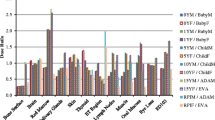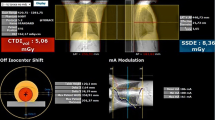Abstract
Background
Organ dose is essential for accurate estimates of patient dose from CT.
Objective
To determine organ doses from a broad range of pediatric patients undergoing diagnostic chest–abdomen–pelvis CT and investigate how these relate to patient size.
Materials and methods
We used a previously validated Monte Carlo simulation model of a Philips Brilliance 64 multi-detector CT scanner (Philips Healthcare, Best, The Netherlands) to calculate organ doses for 40 pediatric patients (M:F = 21:19; range 0.6–17 years). Organ volumes and positions were determined from the images using standard segmentation techniques. Non-linear regression was performed to determine the relationship between volume CT dose index (CTDIvol)-normalized organ doses and abdominopelvic diameter. We then compared results with values obtained from independent studies.
Results
We found that CTDIvol-normalized organ dose correlated strongly with exponentially decreasing abdominopelvic diameter (R2 > 0.8 for most organs). A similar relationship was determined for effective dose when normalized by dose-length product (R2 = 0.95). Our results agreed with previous studies within 12% using similar scan parameters (e.g., bowtie filter size, beam collimation); however results varied up to 25% when compared to studies using different bowtie filters.
Conclusion
Our study determined that organ doses can be estimated from measurements of patient size, namely body diameter, and CTDIvol prior to CT examination. This information provides an improved method for patient dose estimation.





Similar content being viewed by others
References
National Council on Radiation Protection and Measurements (2009) Ionizing radiation exposure of the population of the United States. NCRP Report No. 160, National Council on Radiation Protection and Measurements, Bethesda
Paterson A, Frush D (2007) Dose reduction in paediatric MDCT: general principles. Clin Radiol 62:507–517
National Research Council (2006) Health risks from exposure to low levels of ionising radiation: BEIR VII report. Washington, DC
Brenner DJ (2002) Estimating cancer risks from pediatric CT: going from the qualitative to the quantitative. Pediatr Radiol 32:228–231
Brenner DJ, Elliston CD, Hall EJ et al (2001) Estimated risks of radiation-induced fatal cancer from pediatric CT. AJR Am J Roentgenol 176:289–296
Goske MJ, Applegate KE, Boylan J et al (2008) Image GentlySM: a national education and communication campaign in radiology using the science of social marketing. J Am Coll Radiol 5:1200–1205
Strauss KJ, Goske MJ, Frush DP et al (2009) Image Gently vendor summit: working together for better estimates of pediatric radiation dose from CT. AJR Am J Roentgenol 192:1169–1175
McCollough C, Cody D, Edyvean S et al (2008) AAPM report 96: the measurement, reporting, and management of radiation dose in CT. Report of AAPM Task Group 23. American Association of Physicists in Medicine, College Park. http://www.aapm.org/pubs/reports/rpt_96.pdf. Accessed 28 Apr 2015
Dixon RL (2003) A new look at CT dose measurement: beyond CTDI. Med Phys 30:1272–1280
McCollough CH (2008) CT dose: how to measure, how to reduce. Health Phys 95:508–517
McCollough CH, Leng S, Yu L et al (2011) CT dose index and patient dose: they are not the same thing. Radiology 259:311–316
Boone J, Strauss K, Cody D et al (2011) AAPM report No. 204: size-specific dose estimates (SSDE) in pediatric and adult body CT examinations. American Association of Physicists in Medicine, College Park. http://www.aapm.org/pubs/reports/rpt_204.pdf. Accessed 28 Apr 2015
Strauss K (2014) Dose indices: everybody wants a number. Pediatr Radiol 44:450–459
International Commission on Radiological Protection (2007) The 2007 recommendations of the International Commission on Radiological Protection, ICRP 103. Essen
Shrimpton P, Hillier M, Lewis M et al (2006) National survey of doses from CT in the UK: 2003. Br J Radiol 79:968–980
Deak PD, Smal Y, Kalender WA (2010) Multisection CT protocols: sex- and age-specific conversion factors used to determine effective dose from dose-length product. Radiology 257:158–166
DeMarco J, Cagnon C, Cody D et al (2005) A Monte Carlo based method to estimate radiation dose from multidetector CT (MDCT): cylindrical and anthropomorphic phantoms. Phys Med Biol 50:3989
Jarry G, DeMarco J, Beifuss U et al (2003) A Monte Carlo-based method to estimate radiation dose from spiral CT: from phantom testing to patient-specific models. Phys Med Biol 48:2645
Li X, Samei E, Segars WP et al (2011) Patient-specific radiation dose and cancer risk estimation in CT: part I. Development and validation of a Monte Carlo program. Med Phys 38:397
Staton RJ, Lee C, Lee C et al (2006) Organ and effective doses in newborn patients during helical multislice computed tomography examination. Phys Med Biol 51:5151–5166
Turner AC, Zankl M, DeMarco JJ et al (2010) The feasibility of a scanner-independent technique to estimate organ dose from MDCT scans: using CTDI vol to account for differences between scanners. Med Phys 37:1816–1825
Lee C, Kim KP, Long DJ et al (2012) Organ doses for reference pediatric and adolescent patients undergoing computed tomography estimated by Monte Carlo simulation. Med Phys 39:2129–2146
Tian X, Li X, Segars WP et al (2013) Dose coefficients in pediatric and adult abdominopelvic CT based on 100 patient models. Phys Med Biol 58:8755
Tian X, Li X, Segars WP et al (2014) Pediatric chest and abdominopelvic CT: organ dose estimation based on 42 patient models. Radiology 270:535–547
Li X, Samei E, Segars WP et al (2011) Patient-specific radiation dose and cancer risk for pediatric chest CT. Radiology 259:862–874
DeMarco J, Cagnon C, Cody D et al (2007) Estimating radiation doses from multidetector CT using Monte Carlo simulations: effects of different size voxelized patient models on magnitudes of organ and effective dose. Phys Med Biol 52:2583
Li X, Samei E, Segars WP et al (2008) Patient-specific dose estimation for pediatric chest CT. Med Phys 35:5821
Turner AC, Zhang D, Khatonabadi M et al (2011) The feasibility of patient size-corrected, scanner-independent organ dose estimates for abdominal CT exams. Med Phys 38:820–829
Yushkevich P, Piven J, Hazlett H et al (2006) User-guided 3D active contour segmentation of anatomical structures: significantly improved efficiency and reliability. Neuroimage 31:1116–1128
Petoussi-Henss N, Zankl M, Fill U et al (2002) The GSF family of voxel phantoms. Phys Med Biol 47:89
International Commission on Radiological Protection (1995) Basic anatomical and physiological data for use in radiological protection: the skeleton, ICRP 70. Pergamon Press, Oxford
Schneider U, Pedroni E, Lomax A (1996) The calibration of CT Hounsfield units for radiotherapy treatment planning. Phys Med Biol 41:111–124
Valentin J (2002) Basic anatomical and physiological data for use in radiological protection: reference values: ICRP Publication 89. Ann ICRP 32:1–277
Carver DE, Kost SD, Fernald MJ et al (2015) Development and validation of a GEANT4 radiation transport code for CT dosimetry. Health Phys 108:419–428
Turner AC, Zhang D, Kim HJ et al (2009) A method to generate equivalent energy spectra and filtration models based on measurement for multidetector CT Monte Carlo dosimetry simulations. Med Phys 36:2154
ICRU (1992) Photon, electron, proton and neutron interaction data for body tissue ICRU report 46. International Commission on Radiation Units and Measurements. Bethesda
Cristy M, Eckerman KF (1987) Specific absorbed fractions of energy at various ages from internal photon sources. I. Methods. Oak Ridge National Laboratory, Oak Ridge. Available via crpk.ornl.gov/documents/tm8381v1.pdf. Accessed 31 May 2015
Li X, Samei E, Segars WP et al (2011) Patient-specific radiation dose and cancer risk estimation in CT: part II. Application to patients. Med Phys 38:408–419
Acknowledgments
This work was supported by grant NIH/NCI 1 R01 CA155400-01A1 awarded by the National Institutes of Health, United States Department of Health and Human Services.
Conflicts of interest
None
Author information
Authors and Affiliations
Corresponding author
Rights and permissions
About this article
Cite this article
Kost, S.D., Fraser, N.D., Carver, D.E. et al. Patient-specific dose calculations for pediatric CT of the chest, abdomen and pelvis. Pediatr Radiol 45, 1771–1780 (2015). https://doi.org/10.1007/s00247-015-3400-2
Received:
Revised:
Accepted:
Published:
Issue Date:
DOI: https://doi.org/10.1007/s00247-015-3400-2




